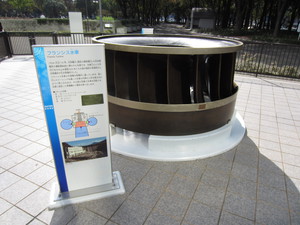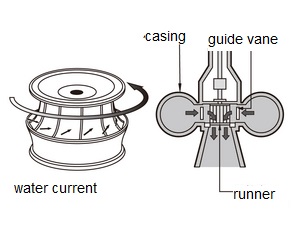Nagoya City Science Museum
TOP > Exhibition Guide > Keyword Search > Starting with "A" > Allis-Chalmers Manufacturing Co. > Francis Turbine
Francis Turbine



Purpose of Exhibition
A water turbine used at a hydroelectric power plant is on display in the yard outside this museum. We would like you to deepen your understanding of electricity, electric power, and electric power generation.
Additional Knowledge
<Water Turbine at the Ohi Power Plant>
This is the water turbine that was in use when the Ohi Power Plant of the KANSAI ELECTRIC CO., INC. was operational. The Ohi Power Plant was designed as a full-fledged dam power plant built in 1924 for the first time in Japan which dammed up a huge river called the Kiso River. The turbine is 2500mm in diameter and it has a huge mass of steel with its weight of 5t casted by Allis-Chalmers Manufacturing Co. in the US, manufactured in 1924.
<What is a Francis Turbine?>
With rotation of the generators, electricity is produced. Attaching a water turbine to a huge generator, hydroelectric power generation is a power generating method with which water turbines rotate with water force. There are various forms of water turbines. The Francis Turbine has a form which suits large power plants. This type of water turbine is named after the inventor and is called "Francis Turbine". Following are its principles: introduce water from outside of the turbine and the force introduced into the wheel rotates the turbine. The water introduced inside falls down from the hub. Electricity is taken out from the generator fixed on the water turbine rotating fast. (Figure)
<Dam Power Generation>
Power plants built before the Ohi Power Plant drew water from rivers situated up the hill and directed it down to a lower position. When the water falls, it spins the water turbine. And the water flow goes back to its river. A water cannel for drawing the river water to the generator was required to be built. It was an insignificant power generating method which did not require any advanced technology. On the other hand, a power-generating dam was constructed on the Shizu River for the first time, a branch river of the Uji River. But why did it have to be a dam? A large amount of water was accumulated in the dam and the difference in elevation was created between the dam and the power plant. This drive causes the water turbine to spin.
However, while the dam's crest of the Shida River was a mere 38m high, that of Ohi dam' was 53m high. It went beyond 50m for the first time in Japan. Moreover, it is important to know that the main stream of the huge Kiso River was held back. In order to build this dam, a delegate of 4 civil engineers from the US was invited and the most advanced civil engineering and construction machinery such as shovels were required. Additionally, while under construction, lack of funds occurred due to the Great Kanto Earthquake. It is well-known that to overcome a shortage of funds, the project was financed with bonds issued in the US.
<Electricity Demand Not in Nagoya but in Osaka>
The Ohi Power Plant started its first operation in 1924. Since Nagoya was not industrialized enough at that time, all the electricity generated on the Kiso River and at the Ohi Power Plant was planned to be transmitted to Osaka. It was 1918 that the construction of the Ohi Power Plant was planned, and the Japanese economy at that time was booming due to World WarⅠ. Electricity demand was on the rise and it was the time when large-scale power plants were required. However, on completion of the construction in 1924, in the recession after the war, it had become a significant issue as to how electricity was going to be consumed.
However, the reservoir that was created as a result of the Ohi Dam, the Ena Gorge, is famed for its spectacular scenic beauty, taking focus off past electricity consumption issues.
Cooperation:
The KANSAI ELECTRIC POWER CO., INC.
Article by Koichi Mabuchi, curator
